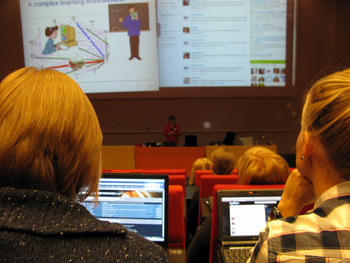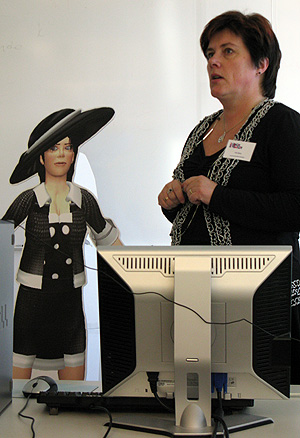The Educational Centre for ICT arranged a trip to the former capital of Finland, Turku, where the E-learning network attended the “Verkkoja kokemassa” -seminar. The seminar is an annual event which – unsurprisingly – explores the themes of e-learning. It’s always nice to visit Turku and as an added bonus I also briefly hooked up with an ol’ friend from the biology studying days. Oh, and a small disclaimer: this is actually mostly a reflection piece for my self and not an exhaustive seminar report. So there, you have been warned… 😉

The first day’s theme was Focus on Students & Sociality – and that´s sociality as in social media: yep, it should come as no surprise that everyone and his grandmother are cultivating the term “social media” in every e-learning sentence these days. Päivi Häkkinen from the University of Jyväskylä introduced a concept that was new to me, “Pedagogical scripts”, which seemed similar to having a screenplay for the course where certain events are scripted (like in computer games) to achieve the desired learning effect. Of course, what this again boils down to is that actual work and planning is required to get any benefits from ICT even in collaborative learning situations. Relying on students sorting matters out among themselves and Just Learning (TM) doesn’t work, and the input of teachers is still needed as computers don’t do the work for them. So the central point from the perspective of e-learning once again becomes: plan how to use ICT correctly.

Second Life (SL) once again reared its blocky 3d-head in one of the workshops. The main presenter Irma Mänty (Laurea polytechnic) had been enthusiastic enough about SL to print a very nice, almost life-sized cardboard copy of her SL-avatar (see picture). Like Irma I also think that identifying with your avatar makes these kinds of environments more attractive and you might behave more like in real life because of that, but I’m also more and more convinced that a free, Open Source environment hosted by the world’s leading universities (for example) is required to really make this kind of environment bloom. Second Life, IMO, is just a bit old fashioned and clumsy compared to modern 3d-games, and a piece of land costs too much, but OTOH it is currently the best bet available and there’s still an ongoing buzz about using SL in education. Some of the teaching examples – like taking students in tourism and language to visit appropriate culturally interesting SL locations (like the virtual Rome) were nice ideas. Again, it requires lots of planning ahead to get educational benefits out of Second Life.
The second day started with a couple of nicely contradictory (or so it seemed initally) talks on video: Olli-Pekka Kangas from the University of Turku demonstrated how much hard work goes into creating good educational videos whereas Mauri Kantola from the Turku polytechnic school wanted teachers to start making videos with the bar lowered as low as possible – think shooting a lecture with your mobile phone and just putting it on the web without editing it (or only slightly with Windows Movie Maker). Of course, these guys were really talking about slightly different things: Mauri wanted teachers to make their first video with no quality requirements, just to get them started and realize that they can use videos for spicing up their educational materials. Olli-Pekka then reminded us of what it then takes to get to decent quality levels – it will cost you lots of time and money too. Like all ICT, a good educational video also requires planning ahead (heard that one before?).
Tarmo Toikkanen held a nice talk about the Creative Commons -license [wikipedia.org], a presentation quite heavily influenced by the (excellent) documentary film RiP: A Remix Manifesto. I’m personally a big fan of the Creative Commons license(s), and it greatly simplifies life in this copyright-jungle world – hopefully it will also make a big splash in education. I do think, however, that if I ever make a hit song, me and my children (and grandchildren) should be able to live off the royalties of that piece of music [wikipedia.org]. That’s only fair 😉
Wrapping up the seminar was self-made man Teemu Arina from his own company Dicole Oy, who I’d previously seen a couple of years ago demonstrating a course running on a blog platform with peer reviewing being a central aspect of the learning process – I liked that presentation. This time the talk was a bit more abstract with lots of flashy visuals and a slight rock star – attitude to the subject, which was a concept called fractal learning. The intellectually stimulating presentation had lots of food for thought but also some things which might have been more style than substance, confusing matters somewhat perhaps. What I’d truly like, however – and this is often missing on any subject regarding pedagogy – is some scientific data to back up claims that “fractal learning” or any such concept is something to “bet on”. I’m always thinking that when we are planning our teaching on certain pedagogical concepts assisted by certain ICT-tools, we’re “betting on horses” in regard to what tools and concepts we use, and the goal is of course to make the students learn what they should optimally learn, that is to “win the race”. So, as a teacher I’d like to bet on the winning horse (not that I really teach, as I’m a support person for teachers, but still…)!
Thus, science is required to help us bet on the right horses, me thinks, and not just on any idea that feels fresh and intuitively innovative. But of course, if a teacher finds that a certain piece of untested theory/technology makes him/her enthuastic about teaching, it doesn’t have to be that scientifically proven – whatever makes you think about what students should learn and how you could achieve that is always a positive factor. We humans like style as well as substance, so perhaps a mixture of both is the winning combination even in education! At least a bit of flair helps the audience in staying awake, people should learn from Teemu in that regard… 😉
All in all, food for thought and a great time in Turku with cool people! Hopefully next year again… and oh yes, from now on I will end every post with a piece of music; the first post-post music is Fever Ray from Sweden with a great song from a suitably autumn-ish album that I’ve recently enjoyed:
[youtube http://www.youtube.com/watch?v=aX07gCjT7dA]
Further reading:
Verkkoja kokemassa – esitykset (presentations on the official seminar page)
RiP: A Remix Manifesto (homepage of the documentary)

2 Replies to “Verkkoja kokemassa: Turku, 8-9.10.2009”
Comments are closed.